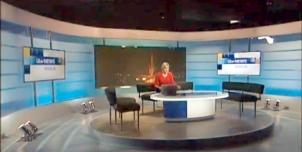Full Freeview on the Sandy Heath (Central Bedfordshire, England) transmitter
| Google Streetview | Google map | Bing map | Google Earth | 52.130,-0.242 or 52°7'47"N 0°14'33"W | SG19 2NH |
The symbol shows the location of the Sandy Heath (Central Bedfordshire, England) transmitter which serves 920,000 homes. The bright green areas shown where the signal from this transmitter is strong, dark green areas are poorer signals. Those parts shown in yellow may have interference on the same frequency from other masts.
This transmitter has no current reported problems
The BBC and Digital UK report there are no faults or engineering work on the Sandy Heath (Central Bedfordshire, England) transmitter._______
Digital television services are broadcast on a multiplexes (or Mux) where many stations occupy a single broadcast frequency, as shown below.
64QAM 8K 3/4 27.1Mb/s DVB-T MPEG2
H/V: aerial position (horizontal or vertical)
Which Freeview channels does the Sandy Heath transmitter broadcast?
If you have any kind of Freeview fault, follow this Freeview reset procedure first.Digital television services are broadcast on a multiplexes (or Mux) where many stations occupy a single broadcast frequency, as shown below.
64QAM 8K 3/4 27.1Mb/s DVB-T MPEG2
H/V: aerial position (horizontal or vertical)
Which BBC and ITV regional news can I watch from the Sandy Heath transmitter?

BBC Look East (West) 1.0m homes 3.7%
from Cambridge CB4 0WZ, 29km east-northeast (65°)
to BBC Cambridge region - 4 masts.
70% of BBC East (East) and BBC East (West) is shared output

ITV Anglia News 1.0m homes 3.7%
from Norwich NR1 3JG, 119km east-northeast (60°)
to ITV Anglia (West) region - 5 masts.
All of lunch, weekend and 80% evening news is shared with Anglia (East)
How will the Sandy Heath (Central Bedfordshire, England) transmission frequencies change over time?
| 1965-80s | 1984-97 | 1997-98 | 1998-2011 | 2011-13 | 12 Feb 2020 | ||||
| VHF | A K T | K T | K T | W T | W T | ||||
| C6 | ITVwaves | ||||||||
| C21 | C4waves | C4waves | C4waves | +BBCB | BBCB | ||||
| C24 | ITVwaves | ITVwaves | ITVwaves | D3+4 | D3+4 | ||||
| C27 | BBC2waves | BBC2waves | BBC2waves | BBCA | BBCA | ||||
| C31 | BBC1waves | BBC1waves | BBC1waves | ||||||
| C32 | com7 | ||||||||
| C33 | SDN | ||||||||
| C34 | com8 | ||||||||
| C35 | _local | ||||||||
| C36 | ArqA | ||||||||
| C39 | C5waves | C5waves | |||||||
| C43 | _local | ||||||||
| C48 | ArqB | ArqB | |||||||
| C51tv_off | SDN | ||||||||
| C52tv_off | ArqA | ||||||||
| C55tv_off | com7tv_off | ||||||||
| C56tv_off | COM8tv_off |
tv_off Being removed from Freeview (for 5G use) after November 2020 / June 2022 - more
Table shows multiplexes names see this article;
green background for transmission frequencies
Notes: + and - denote 166kHz offset; aerial group are shown as A B C/D E K W T
waves denotes analogue; digital switchover was 30 Mar 11 and 13 Apr 11.
How do the old analogue and currrent digital signal levels compare?
| Analogue 1-4 | 1000kW | |
| BBCA, D3+4, BBCB | (-7.4dB) 180kW | |
| SDN, ARQA, ARQB | (-7.7dB) 170kW | |
| com7 | (-13dB) 49.6kW | |
| com8 | (-13.1dB) 49.1kW | |
| Mux 1*, Mux 2*, Mux A*, Mux B*, Mux C*, Mux D* | (-17dB) 20kW | |
| Analogue 5 | (-20dB) 10kW |
Which companies have run the Channel 3 services in the Sandy Heath transmitter area
|
|
Friday, 19 October 2012
N
NJ11:52 PM
I think I have solved my interference problem. Today I had fitted an A0968 28 element log periodic aerial, this replaced the 52 element HG10 WF aerial that was fitted. The improvement in reception is considerable. Although the gain of the new aerial is 4dB lower than the old one, the reception is greatly improved with no bit errors detected on any channel. I have to say the new aerial is mounted on a longer pole, putting the aerial 6ft higher above the roof top. But that said, it may now be necessary to turn down the gain of the distribution amp mux, as all Sandy Heath channel are at the top of the equipment signal strength range, close to overload on one of the DVRs.
Interestingly the new log periodic is smaller than the old aerial, and clearly offers a much lower wind loading.
What I do no understand is why the old aerial produced such poor reception only on one RF channel, channel 27.
| link to this comment |
Saturday, 20 October 2012
NJ: The reason why it only affected one UHF channel is probably down to the fact that they won't all be exactly the same. Had you had more gain, then maybe it would have started to affect other channels.
The is surely not to run it so high rather than wondering why one channel is degraded when others are not!
Digital reception requires good quality. Don't try to run it as close to full strength as possible.
With analogue, the stronger the signal the better the picture. With digital there is a threshold over which the signal can be received. Whilst it is a good idea to have a good margin over that threshold to allow for natural fluctuations, there is no need to strive for as high as you can as it gives no benefit to the picture.
| link to this comment |
Saturday, 27 October 2012
N
NJ7:35 AM
The argument that gain was the issue is clearly incorrect as my new aerial has a slightly lower gain than the old one and experiments were conducted using an aerial preamp that indicating front end gain was not a factor.
As I reported in my earlier postings, my receivers were all reporting high levels of signal, the problem was poor bit error rate.
The way in which the bit error rate changed with time of day suggested that the interferer was a strong reflection subject to Rayleigh or Rician fading.
Since the new aerial made such a difference, I can only conclude that either the old aerial had a notch in its frequency response due to an impedance mismatch problem, maybe the result of a poorly connected cable, which seems unlikely or the small increase in height and the slight change in aerial direction, was sufficient to mask the co-channel interferer. I will not know if the problem has been truly solved until we have experienced the full range of weather conditions.
Given the beam width of the old aerial is 32 degrees, the slight change in direction also seems unlikely to have resolved the problem.
It is worth note that the minimum front to back ratio of the new aerial is better than the old one, with large attenuation peaks across the band. A more complete comparison of the aerial specifications is impossible as the old aerial spec lacks the necessary gain plots.
| link to this comment |
Tuesday, 30 October 2012
S
Steve10:59 PM
By the way the tuning problem with channels in 800s has resolved itself now. Dunno what that was about but not it seems my TV!
| link to this comment |
Saturday, 3 November 2012
S
steve10:26 PM
Why can my internet tv receive meridian broadcast and get all the HD channels, yet my 5 other full HD tv's not receive 1 single HD channel between them from sandy heath?
| link to this comment |
steve: The most common answer to such a question is because they do not have HD (DVB-T2) tuners in.
| link to this comment |
Friday, 9 November 2012
T
Tim Newton5:17 PM
Woodbridge
Hi Brian,
Many thanks for your offer of a dump of the data you are using. I would be keen to take you up on that offer if it is still open. Perhaps you could contact me directly on my e-mail address to discuss?
Many thanks,
Tim.
| link to this comment |
Tim's: mapT's Freeview map terrainT's terrain plot wavesT's frequency data T's Freeview Detailed Coverage
Monday, 12 November 2012
B
Bryan2:00 PM
Hello - We live within about Half a Mile of the Sandy Heath Transmitter - I can see it out of the window looming over us all - & we have a couple of TVs with In Built Freeview. Is there anyone out there familar with the implications of the new 4G Service for those in close proximity to this Transmitter - in view of all the comments in the Press about Interference/Loss of Freeview Channel Access etc. & if this is likely to arise - & what is to be done in practice?
| link to this comment |
K
KMJ,Derby7:37 PM
Bryan: The most likely scenario for problems from 4G signals is a weak Freeview signal being received in an area with a strong 4G signal. If the Freeview signal is then amplified with no steps being taken to reduce the level of the 4G signal the viewer will end up with a super strong 4G signal which is likely to overload the tuner. The problem is worse for viewers receiving C60 or C59 as filtering becomes more difficult. I don't know where the nearest 4G antenna will be in relation to your location, but as you are close to Sandy Heath, so unlikely to have any amplification and receiving frequencies away from those to be used for 4G you will probably have no problems to contend with.
| link to this comment |
Bryan: In addition to the response from KMJ,Derby, 4G signals will be vertically polarised. Your Sandy Heath aerial is horizontal so this is another factor which makes you even more less likely to be susceptible to problems with 4G interference.
| link to this comment |
Select more comments
Your comment please!




